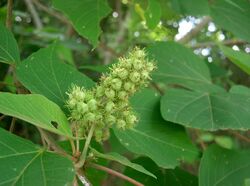Biology:Mallotus japonicus
| Mallotus japonicus | |
|---|---|

| |
| Mallotus japonicus leaves and fruits | |
| Scientific classification | |
| Kingdom: | Plantae |
| Clade: | Tracheophytes |
| Clade: | Angiosperms |
| Clade: | Eudicots |
| Clade: | Rosids |
| Order: | Malpighiales |
| Family: | Euphorbiaceae |
| Genus: | Mallotus |
| Species: | M. japonicus
|
| Binomial name | |
| Mallotus japonicus (L.f.) Müll.Arg.
| |
| Synonyms | |
| |
Mallotus japonicus (Chinese: 野梧桐),[1] also known as East Asian mallotus,[2] the food wrapper plant or "Akamegashiwa" in Japanese, is a plant species in the genus Mallotus native to China. It is also found in Japan and Korea. This species was first described in 1865, its name was verified by AAS Systematic Botanists on October 2, 2015.[3]
The plant is dioecious. The young shoots are red-coloured. The larvae of the moth Deoptilia heptadeta mine the leaves to feed.
Uses
The large leaves were used to wrap food. The young leaves, when boiled, are edible. The bark is used in the Japanese pharmacopoeia as a decoction against gastric ulcer, duodenal ulcer, gastric hyperacidity. In addition, the fruit has anthelmintic properties.
Ecology
Mallotus japonicus shows physical, chemical, and biotic resistance traits against herbivores.[4] Trichomes, which are produced on leaf surfaces, serve as a physical resistance trait. Pellucid dots, which also are present on leaf surfaces, typically contain toxic metabolic substances or essential oils and function as a chemical resistance trait. Furthermore, the plant bears extrafloral nectaries (EFNs) on its leaf edges and food bodies (pearl bodies) on its leaf and stem surfaces as biotic resistance traits. EFNs contain primary sugars, and food bodies are known as lipid-rich particles. These biotic traits attract ants, which remove herbivores from the plant. The plant can change its combination of defence traits in response to leaf age and abiotic habitat conditions,.[4][5]
Chemistry
Mallotus japonicus contains bergenin.[6] The pericarp contains mallotophenone, mallotochromene[7] mallophenone, mallotojaponin, isomallotochromene and mallotochroman.[8] The bark contains 11-O-galloylbergenin, 4-O-galloylbergenin and 11-O-galloyldemethylbergenin.[9] The bark also contains the hydrolyzable tannins 1,2-di-O-galloyl-3,6-(R)-hexahydroxydiphenoyl-beta-D-glucose, 1-O-digalloyl-3,6-(R)-hexahydroxydiphenoyl-beta-D-glucose, 1-O-galloyl-2,4-elaeocarpusinoyl-3,6-(R)-valoneayl-beta-D-glucose (mallojaponin) and 1-O-galloyl-2,4-elaeocarpusinoyl-beta-D-glucose (mallonin) and mallotusinin.[10]
References
| Wikimedia Commons has media related to Mallotus japonicus. |
- ↑ Monograph of Chinese butterflies. Henan Science and Technology Press. 1994. https://books.google.com/books?id=W_shAQAAMAAJ.
- ↑ English Names for Korean Native Plants. Pocheon: Korea National Arboretum. 2015. pp. 533. ISBN 978-89-97450-98-5. http://www.forest.go.kr/kna/special/download/English_Names_for_Korean_Native_Plants.pdf. Retrieved 4 January 2017.
- ↑ "Taxon: Mallotus japonicus (L. f.) Müll. Arg.". Germplasm Resources Information Network. https://npgsweb.ars-grin.gov/gringlobal/taxonomydetail.aspx?23190. Retrieved August 6, 2020.
- ↑ 4.0 4.1 Yamawo, Akira; Suzuki, Nobuhiko; Tagawa, Jun; Hada, Yoshio (2012). "Leaf ageing promotes the shift in defence tactics inMallotus japonicusfrom direct to indirect defence". Journal of Ecology 100 (3): 802–809. doi:10.1111/j.1365-2745.2011.01934.x.
- ↑ Yamawo, Akira; Tagawa, Jun; Hada, Yoshio; Suzuki, Nobuhiko (2013). Heil, Martin. ed. "Different combinations of multiple defence traits in an extrafloral nectary-bearing plant growing under various habitat conditions". Journal of Ecology 102: 238–247. doi:10.1111/1365-2745.12169.
- ↑ Lim, Hwa-Kyung; Kim, Hack-Seang; Choi, Hong-Serck; Oh, Seikwan; Choi, Jongwon (2000). "Hepatoprotective effects of bergenin, a major constituent of Mallotus japonicus, on carbon tetrachloride-intoxicated rats". Journal of Ethnopharmacology 72 (3): 469–74. doi:10.1016/S0378-8741(00)00260-9. PMID 10996288.
- ↑ Studies on Cytotoxic Constituents in Pericarps of Mallotus japonicus, Part I. Munehisa Arisawa, Akio Fujita, Rieko Suzuki, Toshimitsu Hayashi, Naokata Morita, Nobusuke Kawano and Saburo Koshimura, J. Nat. Prod., 1985, volume 48, issue 3, pages 455–459, doi:10.1021/np50039a014
- ↑ Arisawa, Munehisa; Fujita, Akio; Hayashi, Toshimitsu; Hayashi, Kyoko; Ochiai, Hiroshi; Morita, Naokata (1990). "Cytotoxic and antiherpetic activity of phloroglucinol derivatives from Mallotus japonicus (Euphorbiaceae)". Chemical & Pharmaceutical Bulletin 38 (6): 1624–1626. doi:10.1248/cpb.38.1624. PMID 2170038.
- ↑ Yoshida, Takashi; Seno, Kaoru; Takama, Yukiko; Okuda, Takuo (1982). "Bergenin derivatives from Mallotus japonicus". Phytochemistry 21 (5): 1180–1182. doi:10.1016/S0031-9422(00)82451-6.
- ↑ Saijo, R; Nonaka, G; Nishioka, I (1989). "Tannins and related compounds. LXXXIV. Isolation and characterization of five new hydrolyzable tannins from the bark of Mallotus japonicus". Chemical & Pharmaceutical Bulletin 37 (8): 2063–70. doi:10.1248/cpb.37.2063. PMID 2598308.
Wikidata ☰ Q15236078 entry
 |







